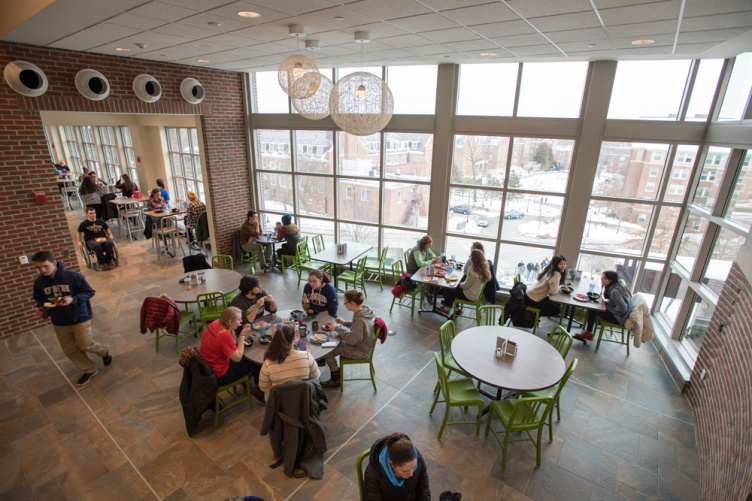Through the Belly of HoCo
March 8, 2023
When a napkin arrives at Holloway Commons Dining Hall (HoCo), it enters how everything else does–at the loading dock. Boxes of the brown paper tissue neighbor local apples in cardboard crates, frozen bags of veggies and even the incoming mail destined for the Student Union. The napkin’s journey to and from the consumer is similar to other products, but its potential is left unharnessed as it meets an untimely death within the bowels of HoCo. So why are napkins excluded from UNH’s composting system when they, too, are compostable?
HoCo is the beating heart of UNH’s center campus. Each day of the 2022 school year, roughly 7,000 students, staff, visitors and the inconspicuous Durham Fire Department pass through the turnstiles. Below the swarm lies a whole new world.
The “back of house,” as Cathy Allen, one of HoCo’s managers and a woman whose smile welcomes you home, calls it, is just as fast-paced as upstairs. The kitchens are abuzz with whirring mixers, rotating ovens, flashing timers and glinting sheet pans. Open ovens and simmering pots wrap the workers in scents ranging from cookies to curry. Energy pulsates as chefs roll racks of thousands of prepped breakfast sausages into a freezer box and cooks in white coats stir massive stainless-steel cauldrons.
Holloway makes most of its own food, even prepping deli meats and baking pastries for Philbrook Dining Hall across campus. Shipments of “raw materials” like potatoes, cheese and spinach come from UNH Dining’s supplier, Katsiroubas. Napkins come from food packaging supplier Imperial Dade. These napkins are made with post-consumer-recycled content, meaning most of the fiber is not coming straight from a tree, but instead coming from already recycled paper. Their brown color indicates that the napkins are not bleached and can be composted without harming the soil. But upstairs, within the steamy walls of the dish room, the napkins end up in the trash, never making it to the compost.
Composting, the process of allowing organic material to break down naturally, is a critical part of sustainability. Organic material, or “stuff” that used to be living, doesn’t decompose normally in landfills. Landfills are sealed to prevent leakages which creates an anaerobic environment – one that lacks oxygen. Microbes, bugs, bacteria and fungi complete the process of decomposition but need oxygen to break down organic materials. Without oxygen, trash sits in the landfill indefinitely, no matter if your cardboard salad bowl is labeled “compostable.” Items such as plastic will be there for millions of years, while organic materials, like paper napkins, sit and ferment, releasing methane, a greenhouse gas many times more potent than carbon dioxide. This is a common paradox of sustainability – hard work goes into sourcing materials responsibly, but often they end up in the landfill nonetheless.
The journey of the napkin progresses as expected: from storage rooms to rolling carts to dispensers. Upon arriving at HoCo, diners grab a few while finding a seat, and post-meal, the napkins end up on the dish return conveyor belt along with ketchup-littered plates and half-empty cups of lemonade. Behind the slowly chugging belt is the dish room where a half-dozen workers, many of whom speak Spanish, scrape food remnants into a lazy river of sludge. These scraps wind their way into the room’s back corner where an industrial food grinder growls as it pulps the food into a tuna fish consistency. But paper napkins are tossed into the trash along with plastic wrappers and crumpled tin-foil. They will never meet the dewy air of Kingman Farm–where the food waste from the UNH dining halls is composted–and disintegrate into the soil, ready to feed a new crop.
Kingman is one of UNH’s premier sustainable showcases. Not only a research farm, Kingman is the final resting place for the Equine program’s horse manure, agriculture barns’ shavings and food waste from UNH’s dining halls and campus-run restaurants. A half-dozen football field-length rows of shavings and scraps decompose in a tucked away field bordered with white pines and red oak trees. Two UNH student hospitality workers, also known as “Compost Crew” members, tip over the yellow buckets off the back of the truck, sloshing out the ground up mush and old eggs from the kitchen. The girls narrowly miss flooding their boots with sludge and falling into the heap below as they laugh and discuss the latest roommate drama. These piles are the end of the road for the preponderance of organic waste from Holloway Commons, but the napkins, despite being completely compostable, are nowhere to be found.
HoCo’s dish room experts tell me that unfortunately, the dish room grinder has its limits. Bones can’t go into the pulp because they chip the blades; banana peels clog the machine’s arteries. And napkins? They too stop up the bowels of the grinder and thus can’t be included in HoCo’s compost. A new machine would cost thousands of dollars and would only increase the quantity of landfill-diverted material by a small amount in comparison to existing volumes. Even though the napkins sit in big trash bins, smaller, twenty gallon buckets filled with food scraps, soggy cucumbers, and still-crunchy onion peels shift to and fro from the dish room to the kitchens to the loading dock. While the napkins are left behind, the rest of HoCo’s organic waste is destined to feed new life on UNH’s farms.
Above HoCo’s turnstiles is a huge blue banner that proudly states, “Award Winning Dining.” And it is true: besides winning multiple grand-prize awards from the National Association of College and University Food Services, all three of UNH’s dining halls are certified Green Restaurants judged by the Green Restaurant Association. Exemplifying Holloway Common’s commitments to sustainability are the half-dozen buckets left at the end of each day. For 7,000 meals served daily, this is a remarkably small amount of waste leftover.
Sustainability at HoCo is honed to a tee: even tomato sauce has been calculated to arrive most efficiently in plastic pouches. Plastic is usually portrayed as the nemesis of sustainability, but sometimes seemingly-harmful items facilitate even higher goals. In this case, plastic pouches are less wasteful than aluminum cans. Shipping is more efficient because of decreased weight and easier packing. Excess sauce doesn’t need to be thrown out because unopened pouches can be heated in vats of water, unlike sauce from cans, which if too much is opened, the excess must be discarded. A testament to its commitments, HoCo even tried making its own sauce from scratch, but the cost difference–an often forgotten pillar of sustainability–was negligible.
Even small changes such as plates have been analyzed. Meal trays were phased out about a decade ago, not only to prevent a catastrophic launching of spaghetti to the ceiling, but to decrease food waste. Limiting how much people can hold reduces waste by guiding them to take smaller portions.
Sustainability is not perfected overnight. Trial and error, experimentation and compromise are often the ways that large and small institutions work their way to a better future. So while HoCo’s napkins won’t ever return to the soil, their neighboring apple cores, last few peas and sandwich crusts will. The thousands of dollars that could be put towards purchasing a new machine that pulps a comparatively small amount of additional waste can now be put towards supporting local farms, reducing energy consumption and tightening up the amount of food discarded in the first place. Compromise is often how things get done, and sometimes, that’s how sustainability works too.





























